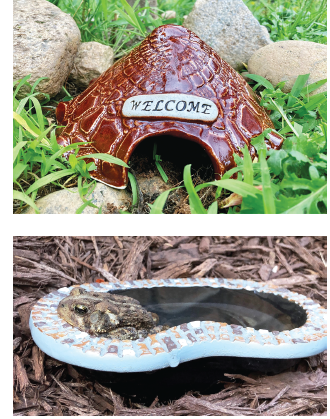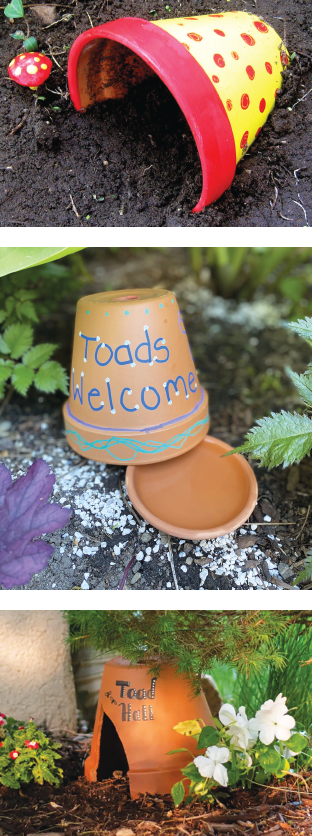No matter the size of a garden, there’s a good chance it would benefit from having a frog or toad put down roots, said Craig Hensley, a Texas Nature Trackers Biologist at the Texas Parks and Wildlife Department.
“Galveston County has a wonderful diversity of frogs and toads that include Gulf Coast, Fowler’s, Woodhouse’s, Eastern Narrow-mouthed Toads, Couch’s and Hurter’s Spadefoots, Pickerel, Green, Pig, Rio Grande Chirping, Crawfish, Spotted Chorus, Southern Leopard, Strecker’s Chorus, and Blanchard’s Cricket Frogs, as well as Squirrel, Green, Gray, and Cope’s Gray Treefrogs,” Hensley said.
Adult frogs and toads are a welcome guest for any garden as they are considered carnivores and feast primarily on insects - including mosquitoes, flies, caterpillars, beetles, cockroaches, slugs, and snails - making them an outstanding form of environmentally friendly pest control.
A single frog can eat over 10,000 insects during a season of gardening, he said.
“Frogs and toads feed on a wide variety of insects and similar prey, helping control some pests, including mosquitoes; they serve as prey for a wide variety of predators from birds to mammals; they also serve as indicators of biological health, whether in a backyard or an ecosystem,” Hensley said.
“They have even been reported to eat cucumber beetles that taste bad to many other predators.”
People can help attract these natural predators to their gardens with just a few changes in gardening habits. The easiest way is to enhance the garden by embracing a more relaxed cleanup approach.
Toads and frogs thrive in a habitat with leaf litter, so leave some under trees and shrubs to provide frogs with a cool, damp environment while benefiting your plants. Opt for dense plantings of native perennials and grasses to offer ample hiding and hunting grounds.
“They, like all wildlife, will do better in a pesticide/chemical-free environment as they are sensitive to toxic chemicals,” he said.
“Providing water in the form of a shallow pond or water feature will encourage them to come on board. The one I have created at home has leopard frogs, tree frogs, and Gulf Coast toads appearing. Before I had the water feature, there were none - and, by the way, they found their way there without me bringing them in.”
Another way to put out the welcome mat is to incorporate fragrant night-blooming plants to attract insects for their nocturnal feasts.
 “Besides water, the best thing you can do is to plant native plants from trees and shrubs to vines, native grasses, and a variety of forbs and wildflowers,” Hensley said.
“Besides water, the best thing you can do is to plant native plants from trees and shrubs to vines, native grasses, and a variety of forbs and wildflowers,” Hensley said.
“Creating a more diverse yard in terms of vegetation and habitat structure will invite more pollinators, birds, and other critters, including amphibians.”
Integrate natural shelters like rotting logs, rock piles, and stonewalls to accommodate toads and frogs, even offering potential hibernation spots.
Construct a rock pile, ensuring a balance of sunlight and shade, with cavities for nesting and shelter. To make them feel welcome, construct a toad abode, he said.
“Create simple shelter for them, such as an overturned pot with an opening or similar for toads, or a small brush pile.”
Avoid disturbing the frogs and toads once they've settled in, and refrain from touching them to preserve their habitat. By prioritizing their well-being, you maintain a harmonious garden ecosystem, he said.
“All creatures need four things to survive: food, water, shelter, and spaces in which to live. As you look at your yard, think like a frog or toad. Is there food in the form of invertebrates? Are there places to hide from would-be predators? Is there a place to have their young, i.e. water?” he said.
“If you can answer ‘yes’ to these questions, you likely have the space for them to live.”
 FROG OR TOAD
FROG OR TOAD
So, how can one discern between a frog and a toad? There are a few telltale signs, Hensley said.
Toads are distinguished by their robust bodies, football-shaped eyes that are set lower, and dry, bumpy skin. They employ shorter hops - or brisk running strides - because of their less robust hind legs.
Conversely, frogs sport slender frames with elongated hind legs, have prominent, bulging eyes, and sleek, mucus-coated skin that imparts a glossy sheen.
Hensley said the most common misperception about toads is that they cause warts if touched.
“They do have toxic skin…should you hold one and then touch your eye, for example, without washing your hands. And, certainly, more than a few pets have learned the hard way that trying to eat one is not pleasant or tasty,” he warned.
“But generally, these are beneficial animals whose presence should tell people they are doing something right in their home environment.”
FROGS AND TOAD ABODES
Both frogs and toads are beneficial to any home garden, consuming hundreds of slugs, snails, grasshoppers, flies, cutworms, and other insects every day. A great habitat for both includes shelter, food, and moisture.
Frogs and toads are often well camouflaged and hard to spot but may come out at night to search for insects attracted by outside lights around houses. Their skin can dry out in heat and sunlight so during the day, they look for cool, shady spots to burrow into the ground and conserve moisture.
You can provide them with an inviting place to stay by providing houses to give them places to spend the day and offer protection from weather and predators
HOW TO MAKE A SIMPLE ABODE
Providing shelter for frogs and toads is easy and a fun way to engage the whole family in creating spaces for wildlife in your yard. Toad and frog houses can be as simple as laying a clay flowerpot horizontally on the ground and burying the lower half under the soil to make a toad cave of sorts.
An overturned clay flowerpot with an entry door chipped out can also provide them with shelter. Decorations are not necessary but can add a whimsical touch to your garden.
Place your house in a shady location near a shrub or plantings. Both frogs and toads cool off and drink through their skin via a process called osmosis so place a shallow container of water, dug in level with the ground with a few stones placed nearby to help them climb out of the water.